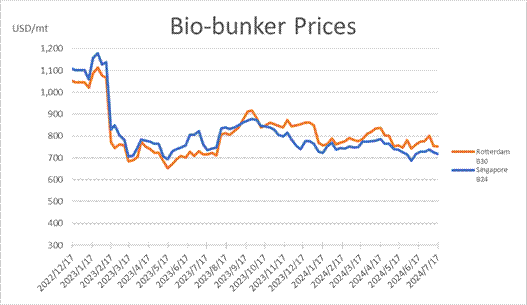|
Indications for VLSFO with a bio-mix of a maximum of 30% in Rotterdam were at $750.00-753.00/mt and a bio-mix of maximum of 24% in Singapore were at $717.00-$720.00/mt, both dropping from the previous week. Deals were reportedly done at a premium of $195-205/mt to FOB Rotterdam Barges 0.5%S fuel oil and at a premium of $116-119/mt to Singapore 0.5%S fuel oil.
Bio-bunker prices are falling due to the decline in prices of used cooking oil (UCO) and Used Cooking Oil Methyl Ester (UCOME) from China. Additionally, demand for bio-bunker fuels weakened, leading to ample inventories. In the EU Emissions Trading System (EUA), CO2 futures prices were hovering in the mid-Euro 66's/mt as of Jul 17.
Prices for UCO and UCOME from China, the world's largest exporter, were on a downward trend. Demand had significantly decreased due to quality control issues reported by collection agents in China. In mid-July, it was reported that edible oil was being collected using unclean fuel transport trucks, further exacerbating the decline in demand. Meanwhile, the European Commission has been conducting an anti-dumping investigation on biofuel imports from China since last December, following claims that biofuels exported from China to the EU were deliberately priced low. The initial findings were scheduled for release on Jun 29 but had been postponed to Jul 19. The investigation might affect imports of biofuels and their feedstocks, such as UCO and UCOME from China. Currently, Chinese UCOME for August was trading at $1,050-$1,080/mt. However, certified UCOME from China continued to be procured by European countries, alongside imports from the US, which helped prevent a steeper decline in prices.
Meanwhile, demand for bio-bunker fuels was slightly weakening owing to competition with LNG bunkers whose prices were attractive. In Singapore and Rotterdam, LNG bunker prices fell to the same level as VLSFO, and demand from LNG-fueled vessels was sharply increasing. The number of barges for LNG bunkering was also expected to rise, positioning LNG as an alternative fuel. Conversely, bio-bunker suppliers faced severe price competition in order to expand demand, but chronic supply uncertainties of biofuels prevented significant price reductions. The increased supply of bio-bunkers such as in the Mediterranean regions and major ports in Northwestern Europe except Rotterdam, as well as in South Korea and southern China in Asia, reduced the opportunities for procurement at the major hubs of Rotterdam and Singapore, contributing to the price decline.
Major shipping company Maersk was reported to reduce investments in methanol to avoid risks and planned to expand its green ammonia and LNG bunker businesses. One reason cited was the delayed supply of green methanol in China. There were growing views that blue/green ammonia could be realistically produced at around 9.9 mil mt by 2027, making it a more feasible bunker fuel than methanol. Both ammonia and methanol fuels are expected to be used in new ships completed from 2026 onward, necessitating a rapid development of fuel supply systems and infrastructure, including ports. There was also a need for buyers to conclude procurement contracts.

|
<PR> Information
|
|
The Bunker Oil report covers bunker oil prices and spot trades at 40 major ports around the world.
It also contains the trend of future fuels such as LNG bunkers and bio-bunkers, container handling volumes, and port operations. LNG bunkers and bio-bunker prices are reported on a weekly basis.
If you learn more, please click the icon on the right side.
|

|
|




